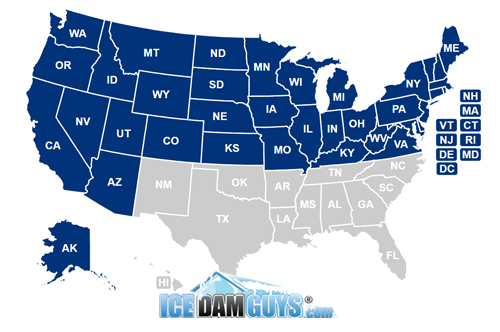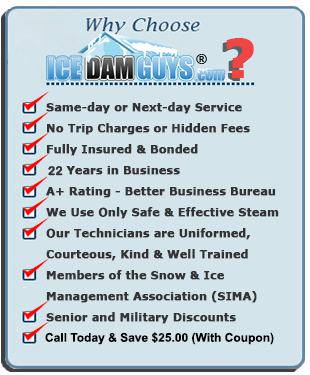Ice Dam Steamers for Ice Dam Removal: 6 Facts on Effective Use
Call us at 1-800-ICE-DAMS if you have an ice dam on your roof and live anywhere in the US, including in Upstate New York, Michigan, Maine, or other hard-hit areas. We are properly licensed, bonded, and insured, and are the top-rated ice dam removal company in the US. You can end the leaks with a phone call to Ice Dam Guys®.
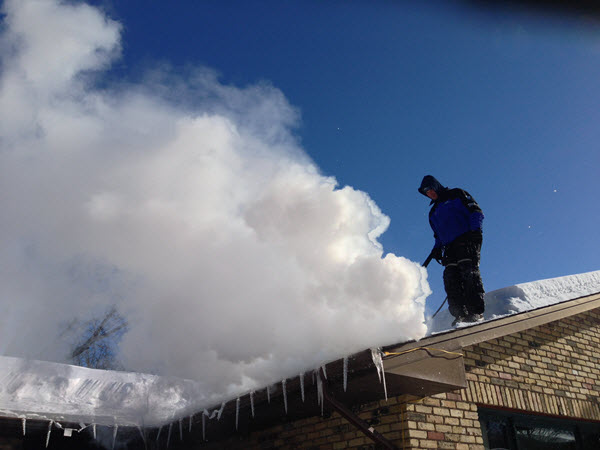
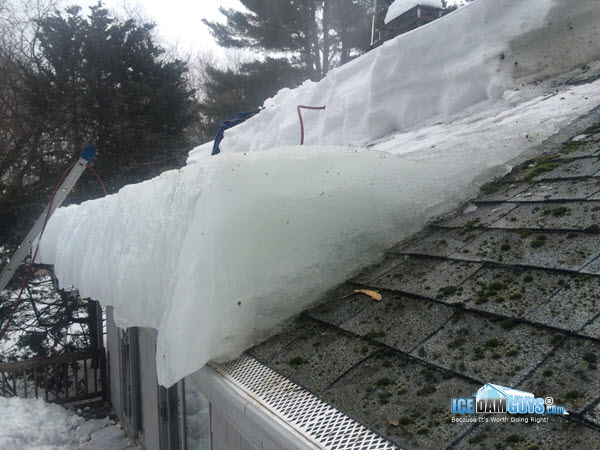
Some ice dam removal companies can’t point to skill, experience, or happy customers, so they create myths to make their equipment sound better than other companies’. Either they’ll try to peg their competitors as users of “pressure washers” rather than of ice dam steamers, or they’ll argue that certain features of an ice dam steamer makes it less able than another to remove ice dams.
If you’ve ever called one of those shrill ice dam companies, no doubt you got an earful of their opinions (presented as facts) on other companies’ equipment – maybe including ours. We’d like to clear the air about a few claims they may have made about ice dam steamers and their proper use.
We’ve removed ice dams for 20+ years and for thousands of homeowners across the US. But we hope you’ll find that our explanations stand on their own. You can decide for yourself what’s a marketing ploy and what makes good sense.
Fact 1: You can retrofit a pressure washer into a superior ice dam steamer.
No sane person would ever “pressure-wash” a roof in the dead of winter.
There was no such thing as an “ice dam steamer” 20 years ago, when some people (mostly us) started taking ice dams seriously. There wasn’t a market for steamers. These days you can buy one online, and fully equipped, for just under $4,000. But proper steamers didn’t exist in that Stone Age of ice dam removal.
So we had to ponder the most efficient, smartest way to get ice and snow off a roof – without damaging the roof. The answer we came up with was, of course, gentle steam. To get a machine that would allow us to create gentle steam, we had to customize a pressure-washer/steamer-combo unit into an efficient steamer. Not an easy task.
Fun fact: The “steamer” our competitors tout is a converted a pressure washer. They look at the five empty holes on the top lip of their “dedicated” steamer and wonder what kind of strange decoration those might be. Those 5 holes are for the pressure-washing tips that their machine had before the manufacturers turned that pressure washer into what they market as bespoke steamers.
A machine that doesn’t blast liquid H2O anymore isn’t a pressure-washer. If you make the water cold enough, and turn the pressure up high enough, you’re Mister Freeze and have a cool ice-gun to use against Batman. Or, if you want to use your power for good, you go in the other direction and find a way to create enough heat and reduced pressure (and other proprietary alterations) and you’ve got yourself a completely customizable steam-gun. That’s exactly what we did.
A caterpillar that matures and morphs eventually becomes a butterfly. If you see a pretty gold thing land on a flower in your garden, you probably don’t say “Oh look, a flying caterpillar.” It’s not the same critter anymore. That principle is true in the mundane world of ice dam removal, too.
Yet that simple point seems lost on Johnny-come-lately ice dam companies that haven’t removed ice dams for long enough to know that there’s more than one kind of steamer. They’ll claim that we or other companies “use pressure washers,” which we do not. We custom-built steamers that they probably couldn’t build, and probably wouldn’t invest in even if they could.
For the past 20 off-seasons (each one spanning 8+ warmer months of the year) we have invested time, money, and know-how into R&D and kaizen. We dubbed the resulting ice dam steamer Steamzilla™, the advantages of which you can read about here. Call us greedy, but we don’t sell them to other ice dam removal companies. We’d rather have our customers benefit from their effectiveness, as thousands of relieved homeowners across the country have.
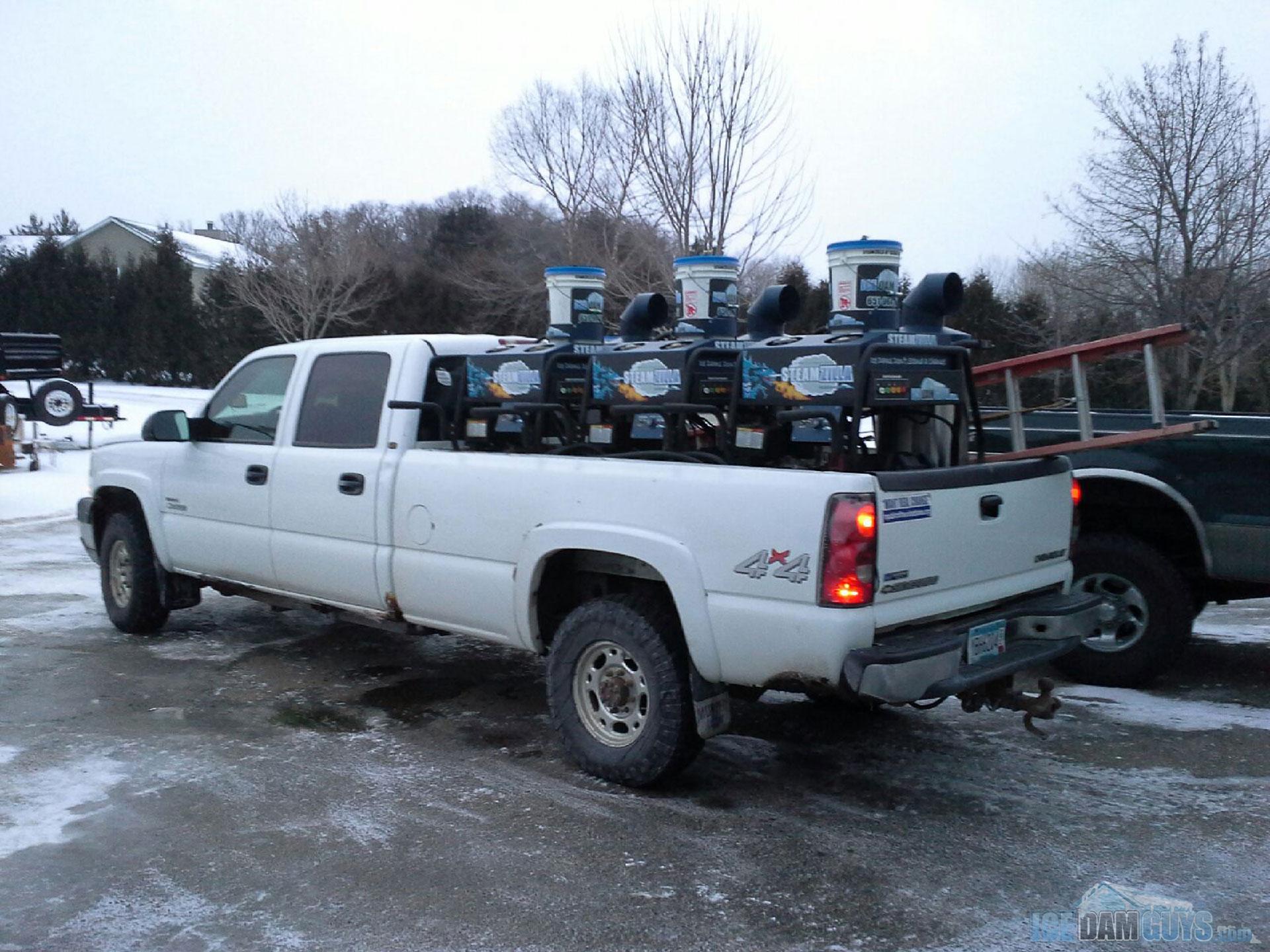
Fact 2: An ice dam steamer with a trigger IS safer than one without a trigger.
Among other things, a trigger serves as a safety measure on our fully customized steamers.
When you’re on an icy roof, many times you need to pause the flow of steam for a moment, and sometimes at the drop of a hat. The more control your ice dam technician has, the better. Control allows him to make decisions about his safety and about the best, safest, and fastest way to get snow and ice off your roof.
Off-the-shelf steamers can’t use triggers, because they are closed-loop systems that will go up in smoke if you try to reduce or stop the flow of steam – even if you must. Our steamers are open-loop, so we can put triggers on our steamers without risking a meltdown.
By the way, we also have steamers without triggers for the occasional customers who have strong feeling about that sort of thing. We know all about the propaganda spread by inexperienced and dishonest ice dam companies, so often we keep trigger-less ice dam steam wands in our trucks, just in case. It takes 3-5 seconds to swap from a triggered wand to a trigger-less wand. Although there’s no tangible benefit to your requesting a trigger-less wand, all you need do is ask us. Please keep in mind that your request may result in a higher bill, because it could increase the number of hours we need to spend on your roof. In essence you limit our ability to control the steam or pressure with precision. (For more info about triggers, see our FAQ.)
Fact 3: Colored tips on the steamer wand don’t mean what you were told they mean.
Dishonest companies may say, “Watch out for anyone with a colored tip at the end of the steam wand – that colored tip means it’s a pressure washer!”
Again, the goal of their skulduggery is to convince you that colored tips are the domain of only pressure washers.
We carry a variety of color-coded tips designed for our machines. The tips allow us to fine-tune the heat, pressure, and the pattern of the steam we use. Just as you need wrenches and screwdrivers of different shapes and sizes for different jobs, we need the right steam for your ice dam removal job. Not all ice is the same, nor is every home the same. We like to have more than one tool in our toolbox.
There’s nothing inherently wrong with an off-the-shelf steamer, and our purpose of this page is not to knock them. In the hands of a professional they’re fine. But it may take longer to do the job, and it may be less safe. That’s not a concern if you’re an ice dam removal company trying to run up the meter, and one that doesn’t putt safety first. But off-the-shelf, trigger-less steamers aren’t helpful if you’re homeowner who likes to avoid unnecessary costs, and one who would prefer no one gets hurt while performing work on your property.
(More on our colored tips here.)
Fact 4: There are two types of steam: wet steam and dry steam.
Wet steam is a mixture of steam and water. Water droplets retain heat much better than vaporized steam can. That makes wet steam the faster, more-surgical option for ice dam removal. It allows us to deploy our chunk-cutting technique faster than we could if we used only dry steam. By the way, the amount of liquid water in wet steam is not enough to compromise your roof.
Dry steam is pure steam, without any liquid water in the stream. There’s nothing wrong with dry steam. It will remove an ice dam. It just takes a lot longer and costs you more money unnecessarily. We believe that’s why other ice dam companies use it. Either that or they simply haven’t invested the time and money to see the difference firsthand. Wet steam is more effective than dry steam ever can be. Often we run our steamers somewhere between wet and dry steam – a little of each. The heat from dry steam plus the heat-retention of wet steam is an effective combination.
Fact 5: Low pressure costs you money.
It’s obvious that the more pressure you have, the faster you can carve ice off a rooftop. Yet the higher the pressure, the greater the risk is that the shingles could suffer from human error. Ultra-high pressure can cut ice like a hot knife through butter, but it can also slice up your shingles like Sous chef.
Conversely, very low pressure will cut through ice much more slowly and with much less risk of damaging shingles as a result of human error. Be careful of companies that brag about how low they go. Lower pressure and lower water volume take longer to melt ice. Conversely, the higher the pressure and water volume, the faster you can melt ice. Most self-proclaimed ice dam “pros” don’t know or choose to ignore that bit of science.
In the last few years, we’ve noticed a claim made by more and more ice dam removal companies: “The lower the pressure, the safer it is on your roof.” It’s not the equipment that damages roofs – people do! If this weren’t true, stoves would shoulder all the blame for overcooking your food – with no blame going to the cook. Until the invention of robotic ice dam removal, human error will always be a concern. The more skilled your technician is, the higher the pressure he can use – making your job go faster.
Many ice dam removal companies (including ours) tout “low-pressure steam,” but rarely do they specify how much pressure they use. One beauty of our steamers is they’re completely adjustable from 100 PSI to 1,000 PSI and beyond, and we also have unlimited control over how much water volume we move (gallons per minute). Our techs can adjust their steamers to remove your ice dams as safely and quickly as possible.
High-pressure steam in the hands of a rookie can cost you money in roof repairs, just as low-pressure steam can cost you money in excessive billable hours. Only an adjustable steamer in the hands of a pro can help you avoid those problems.
Fact 6: The operator’s technique and skill matter more than the steamer itself ever will.
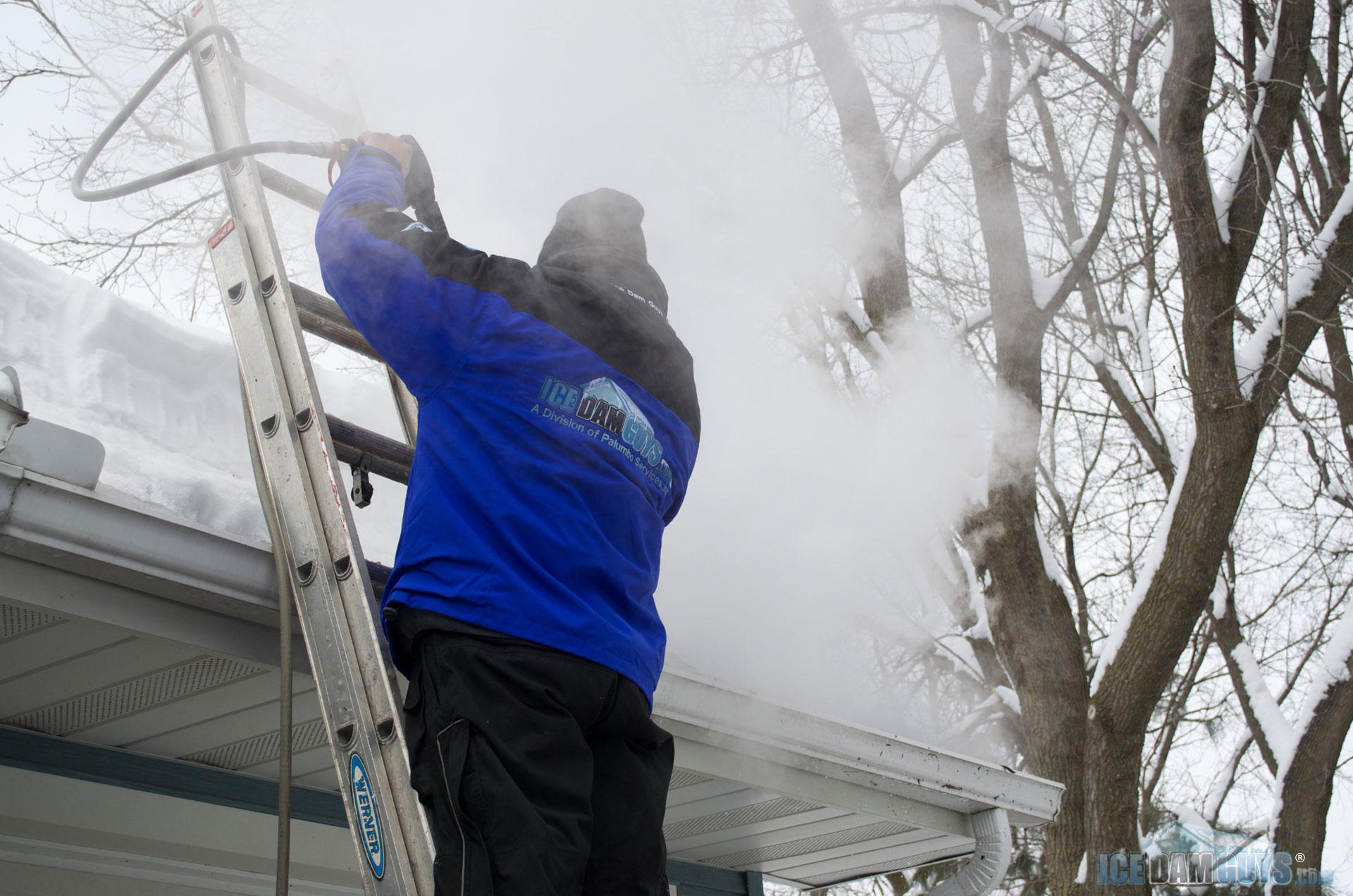
If you need major surgery, do you try to find the surgeon with the fanciest scalpel? No. You try to find the finest surgeon. If your surgeons’ website is all about his or hers fancy scalpel, you might want to find a new surgeon.
You already know that expertise matters more than tools do, more often than not. (Most ice dam removal companies only have clunker equipment, but you get our point.)
Many people think ice is just ice. In reality, there are many decisions and calculations we need make when we’re on the roof to remove an ice dam.
We need to determine when it’s better to blast the ice directly, or to cut channels into it so we can “chunk it” away. We’ve got to navigate skylights, glass roofs, solar panels, copper gutters, and other delicate areas. On multi-day projects, we need to determine how much heat to keep in the attic overnight because that can affect how strongly the ice sticks to your shingles. We hope we make ice dam removal look simple and easy, but it’s anything but simple and easy.
Even after having done removed ice dams for 20+ years, we never see exactly the same job twice, and we learn something new every winter. Mother Nature has a way of humbling the wise. We’re not experts because we know a lot about ice dams, but because we know how many ins and outs there are to know.
Each of our guys receives on-the-job training until he’s an Ice Dam Guys® expert for life (we stop short of tattooing him). Each Ice Dam Guys® tech has one job: make your roof safer without costing you a dollar more than is necessary to bring it to safety. No steamer out there can serve as a replacement for 20+ years of dedicated, 5-star service.
If the deciding factor for you is the “state-of-the-art” steamer the ice dam removal company brags about, the chances are good your almost-rich (soon to be sued) roofer will find out firsthand what happens when the steamer is better than the operator.
Find an ice dam removal company that has a long and public track record of excellent customer service, and make sure that their track record is for ice dam removal and not for their other warm-weather business (like window-washing). Make sure they use wet-steam ice dam steamers gentle enough to help protect your roof from human error, yet powerful enough that it can still cut ice (not too hot, or too high-pressure, or too low-pressure). Do your best to know that the technician they send out to your home is an experienced one.
Bonus advice: If their ice dam reviews look good, find out what their summer business is and
Google that business, too. If you can’t seem to locate their summer business or parent company, there’s a reason they’re hiding it from you. Don’t hire a company you can’t find much information on.















